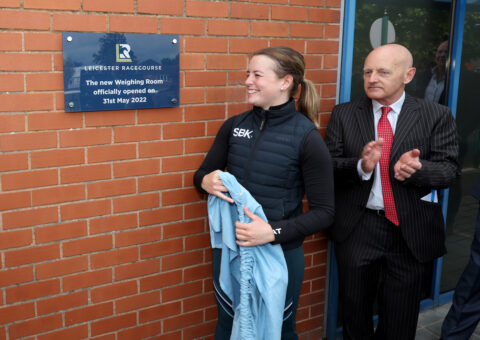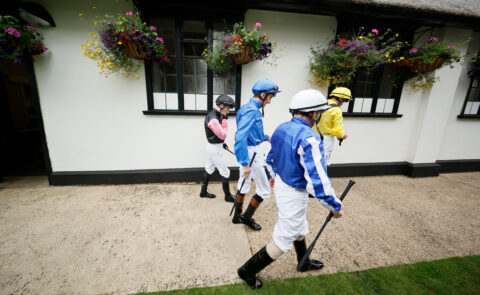Modernising and improving weighing room facilities

Work is underway to upgrade and modernise weighing room facilities at British racecourses. This is being overseen by a cross-industry group of British Horseracing Authority, Racecourse Association, jockey and valet representatives.
While there has been important progress, with major refurbishments and brand-new buildings opened at 12 locations across the country, it is generally accepted that the project has not advanced as quickly as it should have done.
In this blog we set out the background to the project and what needs to happen now to ensure our weighing rooms meet the needs of current and future users.
—————————————–
The weighing room is one of the most important areas on the racecourse. It’s the hub of raceday operations and main working area for key raceday personnel, including valets, BHA officials, racecourse teams, medical staff and many others.
But it’s best known as the place where jockeys prepare for competition and relax between races, ensuring they are ready to perform to the highest-level on the track.
Improving and modernising facilities
In November 2021, racing’s leaders committed to upgrade and modernise the weighing rooms at all British racecourses, with the aim of completing this work by October 2024.
This followed an extensive piece of research carried out by a working group of jockeys, valets, racecourses and BHA representatives, which identified clear areas for improvement, including:
- new communal working space for valets, based outside the changing areas and equally accessible from both female and male changing rooms
- communal rest, food provision and warm-up areas for jockeys
- additional private changing and shower facilities in the changing rooms
- flexibility to adjust layout according to the changing needs of participants – future-proofing the facilities for the next generation.
A safe, supportive and professional environment
Why are these changes necessary? Because while the role of the weighing room has evolved through the centuries, the buildings themselves have not always kept pace.
It was agreed that greater consistency is needed across the country, with the space redeveloped to better meet the needs of jockeys and reflect changing societal expectations.
Our jockeys are elite athletes performing in a professional sporting environment, so the facilities they use should be of a similarly high standard.
We are also a sport where people of all genders can compete directly against each other. But our facilities don’t always reflect this, having been built in an age where almost all jockeys were male.
And we are now much more aware about the importance of providing a safe, supportive and inclusive environment for everyone, including our jockeys and those working on the racecourse.
A phased approach to delivery
Racecourses were first asked to prioritise essential safeguarding measures, such as private showering and changing areas for use by jockeys aged 18 and under – or anyone else who feels more comfortable using them. This work was completed by February 2022.

Page Fuller opens the new facilities at Leicester Racecourse
Next was the more comprehensive weighing room redevelopment, which would require major renovation of existing facilities or, in some cases, complete demolition and a full rebuild.
First out of the stalls was Leicester Racecourse, which opened its fully approved and state of the art weighing room in May 2022 – equipped with jockey warm-up and performance equipment.
A further 11 racecourses have completed their own redevelopment work, with jockeys and those based in the weighing room enjoying more modern facilities and a more effective working environment.
In addition, York racecourse is currently trialling a system of utilising a licensed female valet’s assistant which would help ensure their recently-built weighing room complex will be compliant.
The remainder are at different stages of the process, with some having started construction and others currently going through the approvals process – overseen by a cross-industry group of BHA, racecourse, jockeys and valet representatives.
Practicalities of big construction projects
It’s fair to say that the work has taken longer than anticipated, and understandable that frustrations have been raised about the lack of more visible progress.
In hindsight, the originally proposed delivery date of October 2024 was too ambitious. This was driven by a collective determination that every weighing room needs to be of a sufficient standard, with facilities befitting our elite athletes.
But it was perhaps inevitable, given the scale of the £40+ million project, that there would be numerous obstacles to overcome.
Funding major redevelopment projects is rarely straightforward, particularly given the wider financial headwinds and decline in betting on horseracing faced by British racing. This is most pertinent to racecourses facing the multi-million-pound investment required to complete this work.
To help ease these pressures, the Horseracing Betting Levy Board has made funding available to support delivery via a racecourse loan scheme. This is still a route open to racecourses and use of the scheme is encouraged.
The historic nature of British racing – normally a major asset for our sport – and the age of our buildings can also present challenges, especially around planning and building restrictions and the availability of useable space.
Some of our weighing rooms are listed buildings and therefore subject to more stringent local council protections; others are built on or near floodplains, which requires a more rigorous approach to planning and development so that we mitigate against potential flooding issues. These are issues that have slowed progress.
Utilising user feedback
Practical challenges aside, there’s also been a desire to not just get things done quickly, but to make sure they are completed properly – and in a way that future-proofs the new developments.
Key to this has been getting constructive feedback from jockeys, valets, officials and others who are actually using the new facilities. This insight has been invaluable in supporting and informing the development of other racecourses, as well as embedding new ways of working.

It’s also no secret that the composition and layout of the weighing room complex is something that’s been heavily debated, both in private and more publicly.
There’s not always been agreement on what should be delivered – and finding a consensus has sometimes taken more time than initially expected, with a need for everyone involved to accept and adopt pragmatic solutions.
An example of this may include saunas, which it had previously been agreed would be removed following closure during COVID. However, the re-emergence of saunas as a topic of debate for a period in 2023 may understandably have led to reservations from racecourses about continuing work to remove them.
Accelerating progress
However, timelines have slipped – and quite considerably in some cases. At this point, it is expected that 50 of the 60 racecourses will have completed the necessary upgrade works by the end of 2027.
The approvals group meets every fortnight to consider, review and agree development proposals. The deadline for those racecourses that hadn’t yet submitted plans for approval by the group was 31 October 2024.
This will be disappointing to those who have been waiting for improved facilities and equal access to essential areas. Jockeys in particular will understandably ask the question: why hasn’t this project been prioritised and what is now being done to ensure progress?
The BHA, Professional Jockeys Association and Racecourse Association agreed and implemented interim arrangements to ensure that jockeys of all genders can access the valets, medical room, canteen and rest areas.
This is not perfect and is a temporary arrangement while the substantive work is accelerated. That doesn’t mean rushing into producing sub-standard facilities, as that will be of no benefit to anyone. But work certainly needs to be expedited.
We have seen in the racecourses where the work has been delivered that the new layout works well (a few minor teething issues aside) and we have a strong blueprint that needs to be replicated across the country.
We are currently running an audit on racecourses’ progress on implementing the interim measures, as well as their progress on the overall delivery of the redevelopment project. If there are any areas of concern this can be addressed through the racecourse annual licensing process, with action to be taken where required.
The onus is on everyone with a stake in this project to now make this a reality across the country. It’s what our participants deserve and what British racing expects.
